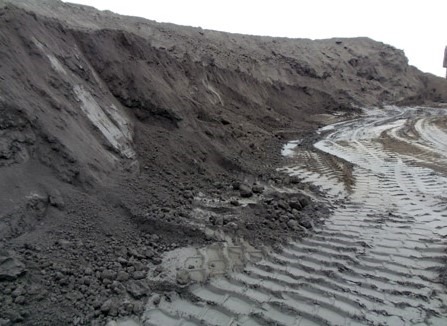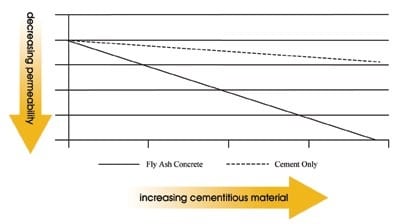Effects of the Fly Ash on Durability of Concrete
Fly Ash is used as an admixture in concrete. The durability of the concrete with fly ash is discussed here.
The use of concrete in aggressive environmental conditions has been increased substantially. Concrete structures are used to provide support for types of machinery, staff, and products of oil and gas exploration and production.
The concrete structures are used in a nuclear reactor to keep the gases and vapors which released at high temperature and pressure in emergency situations. The fly ash plays an important role.
Effects of Fly Ash on Durability of Concrete
It has effects like
- Permeability of Concrete
- Carbonation of Concrete
- The durability of concrete subjected to repeated cycles of freezing and thawing
- Abrasion and erosion of fly ash concrete
- Sulfate resistance of concrete
- Alkali aggregate reactions in concrete
- Corrosion of steel reinforcement in concrete
- Concrete exposed to seawater

Effect of Fly Ash on Concrete permeability
The permeability of concrete is based on the quantity of hydrated cementitious material at any given time. It is said that the permeability of fly ash was lower than the permeability of controlled concrete after 28 days of curing.
On the other side after six months the fly ash concrete is more impermeable and also achieves substantial imperviousness. The above difference is because of the pozzolanic activity of fly ash and the pozzolanic reaction is low at the beginning.
This is how the fly ash could produce better concrete durability.

Fly ash effect on Carbonation of Concrete
The carbonation is where the carbon dioxide in the air which reacts with calcium hydroxide, calcium silicate and aluminates in hydrates cement and make calcium carbonate.
This process took place in mostly moist situations and the rate of the carbonation of concrete is specified by concrete permeability, saturation degree, and quantity of calcium hydroxide which is ready for the reaction.
The carbonation is the main reason for the steel corrosion resistance. The main focus should be on proportions of concrete mixture, concrete cover and the period of moist curing when a high amount of fly ash is used.
The effect of fly ash on the durability of the concrete with repeated cycles of freezing and thawing
If the concrete is made with exact proportions it has become frost resistance. The fly ash may lead to an increase the number of admixtures that are necessary to obtain the particular level of entrained air and it is also influenced by entrained air stability in fresh concrete.
The research is carried on the effect of the fly ash on the durability of concrete for repeated cycles of freezing and thawing and supports the statement by Larson that Fly ash has no apparent ill effects on the air voids in hardened concrete.
When the proper volume of air is entrained the characteristics of the void system meet the criteria.
Abrasion and Erosion of Fly Ash Concrete
There are many situations where concrete is used for scraping, attrition, sliding of cars, ice, and other items. It has been said that the concrete resistance against abrasion is proportional to its compressive strength.
The low abrasion resistant fly ash concrete might expect unless the concrete is adequately and thoroughly curried. It is proved that concrete with ASTM class F fly ash provider for better abrasion resistance than the ASTM class C or with no fly ash content.
The concrete is eroded when the water flows over the surfaces. With the fixed slump value, the concrete resistance against erosion can be increased by increasing the strength and cement content.
Fly Ash effect on Sulfate Resistance of Concrete
It is proven in research carried out by Dikeou that sulfate resistance of concrete can be improved by using fly ash.
The effect of fly ash on alkali-aggregate reactions on concrete
It is proven that fly ash is very effective in decreasing the detrimental effect of alkali-aggregate reactions (AARs). This effect is only decreased where the siliceous aggregates are involved.
The alkali-aggregate carbonation is one type of AAR that is less responding to fly ash inclusion. But the expansion of alkali-aggregate can be decreased with low calcium fly ash replaces the 25-30 percent and under the condition that alkali is less than four percent.

Effect of the fly ash on the corrosion of steel reinforcement in concrete
There is always a concern of corrosion of steel reinforcement in fly ash concrete. This is happened because of chloride ions from the seawater or de-icing. It has happened when the carbonation depth in concrete reaches the steel reinforcement and if the oxygen and moisture are reached to the surface of the reinforcement the steel bar will corrode.
It will be protected from corrosion if the fly ash concrete cover is sufficient.
Fly Ash effect on concrete exposed to seawater
The concrete used in marine has a danger of wetting and dying, waves, abrasion by debris and sand, freezing and thawing cycles and reinforcement corrosion which are occurred in a chemical medium.
But the entirely submerged concrete is less affected by the above factor. If the fly ash concrete has 25 percent replacement by mass and it is under the condition of water to cementitious materials less than 0.50 have a good performance under freezing and thawing and wetting and drying conditions.
